West Launceston Primary 3/4a
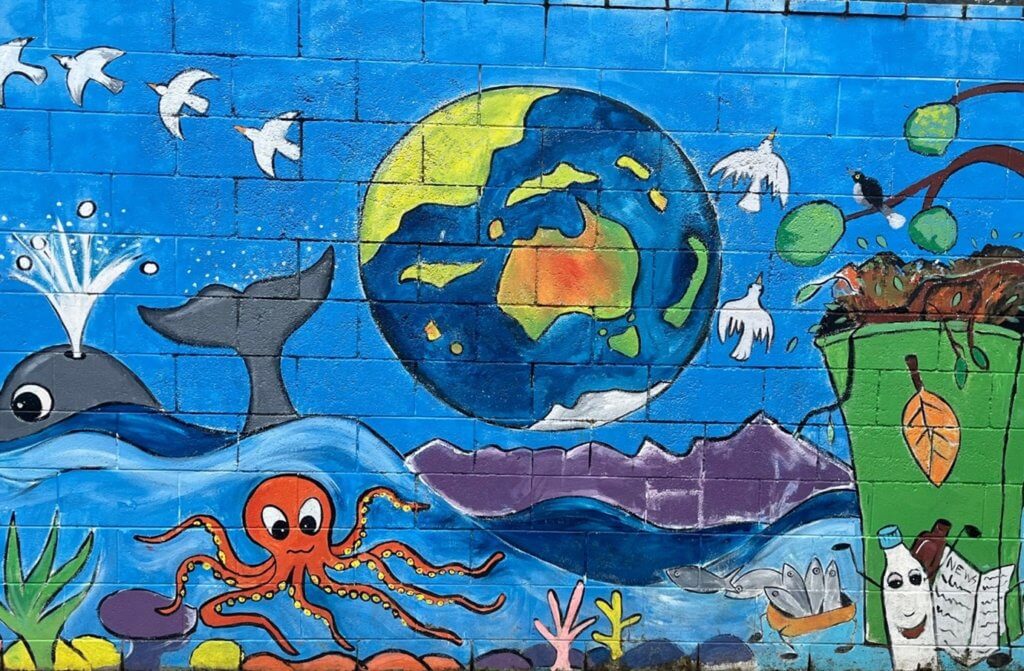
Hey West Launceston Primary!
Thank you for your questions about climate change. You asked some really interesting questions about climate science, the future and animals!
You'll find answers to your questions from our climate experts below - have a read and watch their answers.
You can also have a look at what other classes across Tasmania asked this year, as well as our climate change toolkit.
Our Questions
Climate change is absolutely will mean that many jobs will be changing into the future. We have already seen big changes in the jobs available due to climate change. Some of these changes offer new opportunities. For example, there are more jobs in renewable energy - the renewable energy sector currently employs about 26,000 people in Australia. Tasmania has jobs in hydro and wind electricity generation, and potentially in a new green hydrogen production industry. The future of jobs in this sector however depends on policy decisions made at the moment.
Some existing jobs have also changed due to climate change. This includes jobs in agriculture, manufacturing, and construction. Many of these jobs will still be a part of our society going forward, but they will probably look different than they have previously. We’ve also seen a shifts in law, with environmental law becoming a specialty area, and changes in social work as greater focus is being placed on disaster response. There are also opportunities for jobs as climate change educators and science communicators. As well as jobs in creating resilient communities, and disaster preparedness.
Climate change will also present some challenges to jobs in the future. Extreme weather events are likely to have impacts on working conditions and safety.
At the moment in particular we want to be encouraging decision makers to be considering the future of climate change as they make policy decisions. You may also like to think about what you’re passionate about, what your talents and skills are and how you could contribute to climate change as you think about what job you’d like to do in the future. What brings you joy and how can you use that to help respond to climate change.
I’ll focus on the greenhouse gases, the ones that cause climate change, with the main ones being carbon dioxide (CO2), nitrous oxide (N2O), and methane (CH4). Scientists started measuring CO2 in the atmosphere in the late 1950s, collecting flasks of air from a mountain in Hawaii. These measurements are a pretty good indication of CO2 in the whole atmosphere, because the gases in the atmosphere get mixed around quickly and have about the same concentration everywhere. This graph (from here: https://gml.noaa.gov/ccgg/trends/) shows the CO2 measurements from Hawaii:
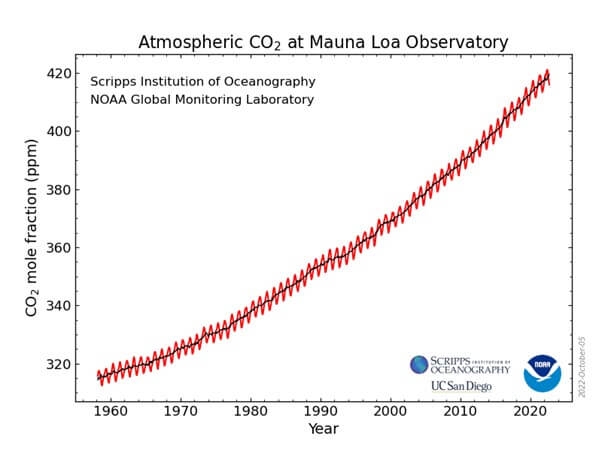
You can see the CO2 concentration has been increasing ever since the measurements started. It was 316 ppm in 1958, 327 ppm when I was born in 1971, 385 ppm in 2007 when my twins were born, and 416 ppm in September 2022. See if you can use the graph to work out what the CO2 concentration was when you were born. There’s an interactive version here: https://gml.noaa.gov/ccgg/trends/graph.html
Over time scientists began to make measurements at more places around the world, including in Tasmania. This graph shows CO2 concentration at Cape Grim since 1984:
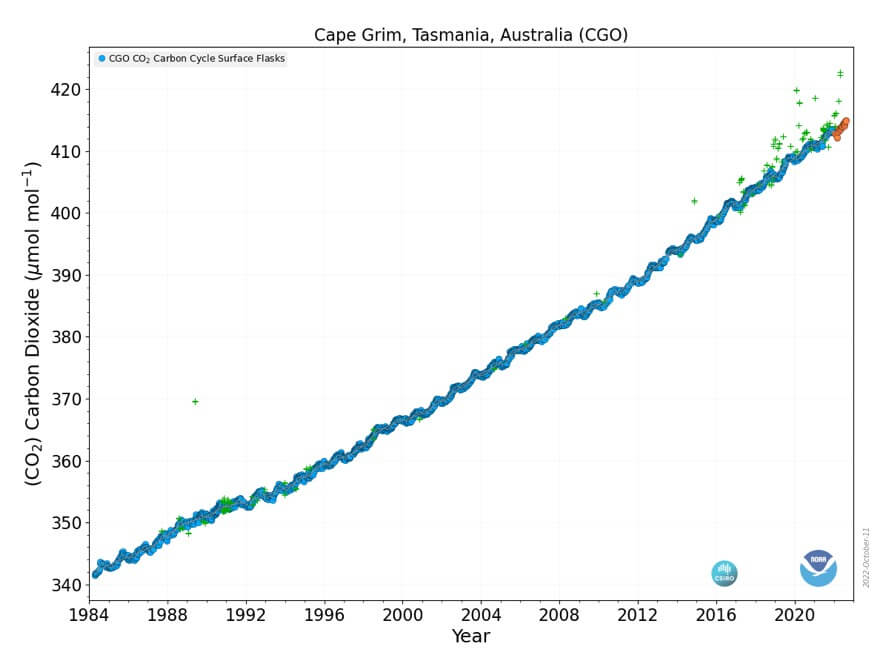
Finally, we even know how gases changed before scientists started collecting samples from mountains. This information comes from bubbles trapped in ice cores, which preserve the air that was around at the time the ice formed. The oldest of these ice samples are 800 thousand years old! The graphs below, from the IPCC 6th Assessment Report, show greenhouse gas concentrations going back 800,000 years. The data on the right-hand side, showing ‘ambient air’, is from flasks like in the graphs above.
What you can see from these graphs is that
- Greenhouse gas concentrations varied quite a lot even when there were no humans around
- Greenhouse gas concentrations have increased very quickly since 1900 (notice that the timescale on the right is expanded compared to the others)
- The concentrations of CO2, CH4 and N2O are higher now than they’ve been at any time in the past 800,000 years.
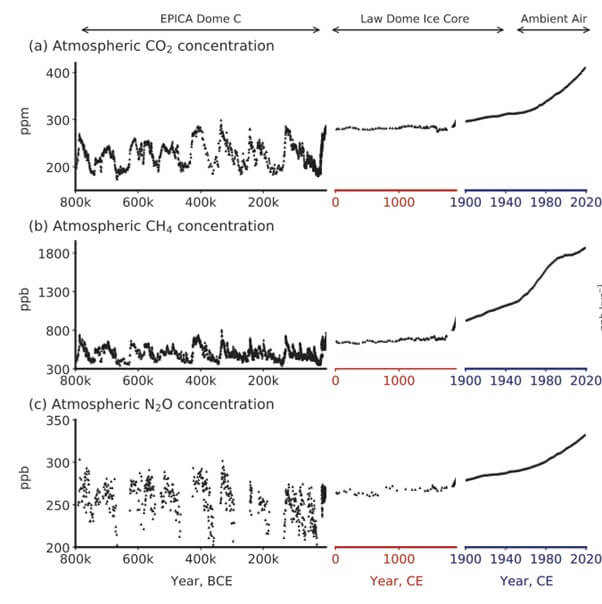
There is a great animation available on youtube that shows how CO2 in the atmosphere has changed.
The how and the why of climate change are very tightly linked, so tightly linked people as far back as 1896 had figured out the basics of how it works. Earth’s atmosphere keeps the world warm by trapping heat. It does this in a way similar to the way a greenhouse works (thus the name “greenhouse effect”). Sunlight (and warmth) can come through the atmosphere in the day time and warms up the land and sea areas. At night cooling occurs, with the heat escaping into the atmosphere, some of that leaks out into space again, but not all because the atmosphere traps some of the heat. The key bit of the atmosphere that traps the heat are the greenhouse gases.
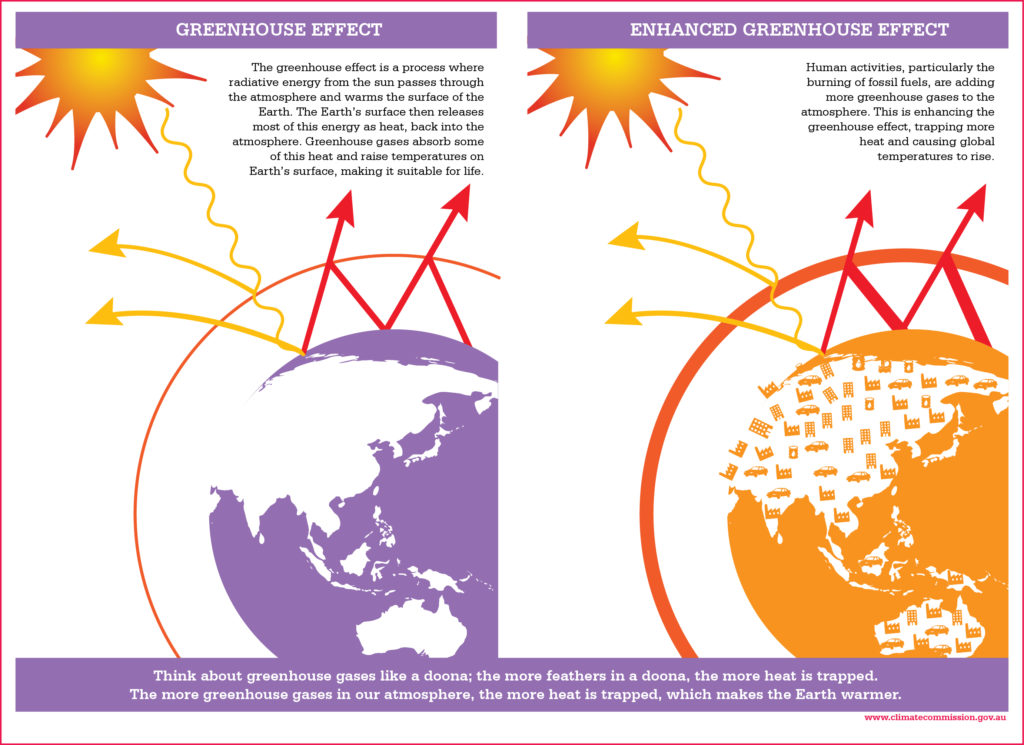
Natural greenhouse gases are water vapor, carbon dioxide, methane, ozone and nitrous oxide. These chemicals are an important part of the world’s natural cycles. They cycle between the atmosphere, the ocean, soils and rocks. Human activities have changed those cycles, meaning more greenhouse gases have entered the atmosphere, trapping more heat and leading to global warming and climate change.
Many human activities influence climate relevant cycles, but two of the most important are to do with carbon dioxide and methane. Fossil fuels contain carbon dioxide locked up millions of years ago, by bringing it to the surface and burning the fossil fuels human activity short circuits natural weathering and other cycles, creating one of the major sources of the excess carbon dioxide that is creating climate change.
Agriculture is also a major contributor to climate change, producing about a quarter of all current greenhouse gas emissions. These emissions come from the fuels used by farmers, but also because of emissions from rice paddies and livestock, which produce methane. A particularly powerful greenhouse gas, over a 20-year period methane is 80 times more potent at warming than carbon dioxide. On top of this, the removal of native vegetation, like forests, to create space for agriculture reduces the amount of carbon drawn out of the atmosphere and stored in trunks and roots as trees grow (known as sequestration).
As you can see there are many interconnected ways that human activities are influencing the biogeochemical cycles of Earth and thereby contributing to climate change.
Good sources of climate information are https://climate.nasa.gov/ and the new IPCC climate atlas https://interactive-atlas.ipcc.ch/
Two good Australian information sources are the CSIRO https://www.csiro.au/en/research/environmental-impacts/climate-change/Climate-change-QA and the Academy of Science https://www.science.org.au/education/immunisation-climate-change-genetic-modification/science-climate-change
You might also like to play with the simple climate model at en-Roads, explore options for reducing climate change https://en-roads.climateinteractive.org/scenario.html?v=21.10.0
Plants and animals are threatened by lots of things like habitat loss from land clearing, or being hunted, fished or harvested. On top of these pressures are climate change impacts.
Because there are so many interacting threats to biodiversity, we haven’t yet attributed many species’ extinctions only to climate change. Species that we have lost to date from climate change are species that occur only in one place, so they are very rare, and those places are exposed to immediate climate impacts such as flooding and sea level rise.
The Bramble Cay Melomys was an Australian rodent that occurred only on one island in the Torres Strait. In 2016, it became the first recorded species extinction attributed to human induced climate change. The small sand island it lived on was affected by sea level rise and storm events. The extinction record by the State of Queensland said that extinction was caused by "ocean inundation of the low-lying cay, very likely on multiple occasions, during the last decade, causing dramatic habitat loss and perhaps also direct mortality of individuals" (1). There are likely other species that have been lost to a similar fate.
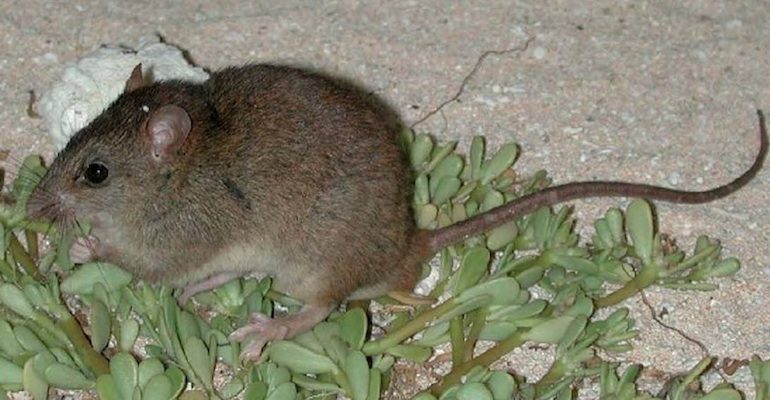
The IUCN Red List of species is the best source for understanding global threats to species. Expert have listed climate change as a cause of decline for 19% of all species listed as near threatened or threatened. Climate change impacts that threaten species include increases in storms, flooding, extreme temperatures, drought, and sea level rise.
As an example – Hooded seals are a species threatened directly by climate change. Their population has dropped in abundance by 90% in the northeastern Atlantic Arctic over the last 20 years. This decline is attributed to loss of sea ice which has reduced the number of places available for resting and raising pups.
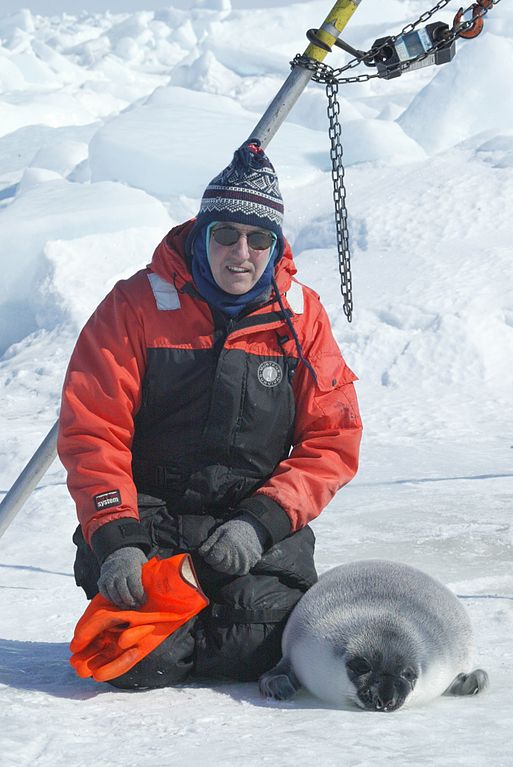
Looking into the future – One study estimated that if we follow our current, business-as-usual trajectory of climate change, which is projected to lead to a 4.3°C temperature rise, climate change would threaten one in six species (16%). This could as much as double our extinction rates.
This is one of many reasons why people are calling for governments to limit climate change to 1.5°C, by ‘decarbonising’ our economy – or stopping emissions of CO2. If we do this, we can reduce the rates at which plants and animals become extinct.
La Niña is part of a natural cycle called the El Niño-Southern Oscillation, or “ENSO.” La Niña, and its counterpart, El Niño, have a strong influence on the year’s weather for most of the country. It’s a weather pattern that occurs in the Pacific Ocean. When the circulation is in La Niña, it picks up the warm water near Australia, carries it over the ocean east towards South America where it descends, and the deep cold water from South America is pushed west towards Australia. (An El Niño happens when the circulation is weaker or pushing in the opposite direction.)
La Niña is a weather pattern that occurs as a natural weather phenomenon. However, climate change impacts the severity and frequency of the impacts of La Niña such as increased rainfall, extreme temperature, earlier monsoon onset and tropical cyclones.
World Meteorological Organisation Secretary-General Prof. Petteri Taalas states, “human induced climate change amplifies the impacts of naturally occurring events like La Niña and is increasingly influencing our weather patterns, in particular through more intense heat and drought and the associated risk of wildfires – as well as record-breaking deluges of rainfall and flooding”.
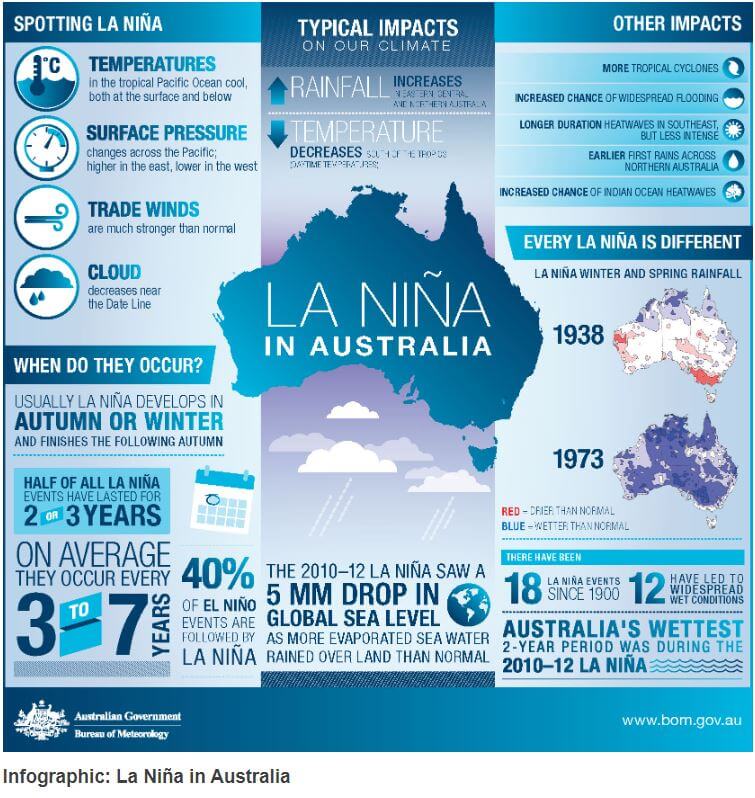
Stopping, or reducing climate change, known as mitigation, is something that is really important so I’m very glad you’ve asked how to do this.
Reducing climate change will involve lowering the level of greenhouse gases in the atmosphere. This means reducing the emission of heat-trapping greenhouse gases. This is done by reducing the use of fossil fuels and moving to renewable energy sources, like wind, solar and ocean wave energy instead. The effectiveness of these energy sources is improving all the time and around the world (especially in Australia) they are becoming a major source of energy already. Increasing efficiency and finding ways of reducing energy use and waste is also very important. Around the world businesses and governments are making commitments to reduce the use of fossil fuels and to transform manufacturing, food production and transport (e.g. trucks, cars, trains and shipping) to electricity or other fuels (like hydrogen).
Another way to help mitigate climate change is to support processes that actively remove carbon out of the atmosphere. Healthy oceans, forests and soil are great carbon stores. This means restoring and protecting these environments and supporting sustainable practices will help. Growing trees is a great way of helping remove carbon from the atmosphere. This effect is so large that the natural regrowth of Tasmania’s forests means that the state is currently a carbon sink – meaning more carbon is removed from the atmosphere than is emitted. This means as a state Tasmania is doing better than the net zero emissions target governments around the world are talking about.
Rather than just letting the trees do all the heavily lifting though we can help Australia and the world by reducing our individual emissions. On a personal level that means turning lights and appliances off when you’re not using them; putting on a jumper rather than turning the heating up to full; and walking, cycling, or using public transport if we can. Also finding out about what you eat and changing to options that contribute less to climate change can also help. Agriculture is a major producer of greenhouse gases so look for low carbon meals, such as sustainable seafood and local seasonal foods, and try having at least a couple of red meat free days a week.
In addition to reducing energy use we can also consume less (e.g. use clothes for longer rather than chasing the latest fashion look), increase recycling and appropriately dispose of organic waste (e.g. food scraps). Methane is a powerful greenhouse gas, over twenty years it is about 80 times more potent at warming than carbon dioxide. When food and garden waste is buried with general garbage the microbes and chemical processes that break the waste down cannot easily access oxygen and so they produce a lot of methane (known as anaerobic breakdown). However, if you put the organic waste into a compost bin (at home or one provided by the council) the microbes can access oxygen and so they use a process that produces much less methane (known as aerobic breakdown). The nutrient rich compost that results also means more plants can be grown (absorbing carbon) and less energy is needed to make artificial fertiliser. A win-win-win.
The biggest thing you can do to help climate change is to stay informed, to help share useful information and to think about your actions – each little bit really does help. Around the world innovations and action by young people is helping accelerate action to reduce climate change.
For starters, you might like to find out how Tasmania’s tree growth is helping our carbon budget. NASA also has a great page on climate change, which mentions some solutions. The United Nations also has some high-level information on different activities around the world.
You might also like to play with the simple climate model at en-Roads, explore options for reducing climate change
Climate change and its causes will affect your generation in many different ways, in Australia and elsewhere. These include rising average temperatures, more frequent and severe storms, floods and bushfires, and extinction of plants and animals. The loss of topsoil from drought, flood and wind and unpredictable weather will affect farming and could cause more frequent and severe famines. This could lead to increasing political tensions in some countries around access to resources. People and governments will need to spend more money on safety and preparedness. These impacts are all related to one another.

A lot of produce will become more expensive as environments change. This includes coffee and honey, and even some vegetables, fruits and meat. Campfires, burn-offs and open-flame barbeques would be restricted for longer parts of the year as fire bans become increasingly common. Take the example of the 2020 bushfires. More than 3 billion animals were impacted, forests were damaged or destroyed, and human tragedies included loss of life, health, homes and livelihoods. Crises like this would be repeated in increasingly worse fire seasons, meaning bigger and bigger expenses for fire preparedness. Taking action on climate change will not stop these impacts entirely, but it can reduce them.
Climate change and its causes impact more than the natural environment. They have knock-on impacts in health. Air, water and soil pollution will continue to cause health conditions and worsen existing ones like cardiovascular and respiratory diseases as well as cancers. While these outcomes are less common in Australia, they happen here too. People in poorer communities with fewer support structures are impacted most. Your generation will see these impacts in your lifetimes. In fact, you already have. Increased exposure to new infectious diseases in the environment has also been linked with climate change, meaning epidemics and pandemics may be a thing of the future and not just the present.
While these impacts cannot be stopped completely, there is so much that can be done to avoid the worst of it. If we rapidly reduce the greenhouse gas we emit, we can improve the future for your generation and the generations who follow you. Action on climate change now will play an important part in your future quality of life, and in the lives of many others around the world in your lifetime.
What will happen to animals? The answer is- it depends. Some will move around to find new places to live. Some will evolve to the new climate conditions where they currently live. And some species will die or go extinct. Let’s look at how species might respond and why this means that even with evolution and moving, some will still die.
Species are evolving and moving in response to climate change. Examples of evolution are changes in how a species can tolerate extreme temperatures – known as thermal ranges. Some species will die at particular temperatures. For example in late 2018 many flying foxes died in an extreme heat wave in northern Australia. Marine heatwaves result in mass coral reef deaths.

But if individual plants or animals within a species happen to have or abilities to survive at higher temperatures, then, over time, those traits will become widespread within the species, because those individuals survive and reproduce. In fact, scientists are selectively breeding coral reefs for their ability to tolerate higher temperatures and then farming these corals to improve the health of the Great Barrier Reef.
Some species can also move around in order to follow suitable climate conditions (like the right temperature or rainfall for them). Plants use wind to move seeds kilometres away, birds can fly long distances to find the next suitable tree hollow to live in, and mammals can follow habitat corridors like rivers and tree lined fences to find the next forest to live in. In this way, some species can continue to adapt and follow changes in their habitat to survive. Scientists call this ‘species on the move’ and it’s a big area of current research. These scientists estimate that so many species will move or redistribute themselves, the types of plants and animals you see out your back door today may well be different in the future.
But evolving, or moving, takes time. Evolution is a multi-generational process. And species tend to move anywhere from a few metres to 10s of kilometres each year depending on how big and how mobile they are. If climate change outpaces the speed at which species can move or change, then they are at risk of dying.
One study estimated that if we follow our current, business-as-usual trajectory of climate change, which is projected to lead to a 4.3°C temperature rise, climate change would threaten one in six species (16%). This could as much as double our extinction rates.
The species that are most likely to be at risk of extinction are those that are on islands (like New Zealand and Australia) where there’s not enough space for species to move or track their preferred climate. So here in Australia, we will have more species extinctions due to climate change relative to other parts of the world.
This is one of many reasons why people are calling for governments to limit climate change to 1.5°C, by ‘decarbonising’ our economy – or stopping emissions of CO2. If we do this, we can reduce the rates at which plants and animals become extinct.
Thanks for asking about whether there are positives from climate change. What a great question! Climate change is posing real challenges for people and for nature but not everything is negative everywhere. The most obvious changes in nature include our findings that plants and animals are moving into areas where those particular species have not been before. This is because areas further away from the equator are becoming warmer and allowing tropical and subtropical animals to move into temperate areas, and those in temperate areas to move into polar areas. In fact, polar regions in the Arctic and Antarctica are “greening” with the arrival of larger plants.
A good example of animal arrivals in Tasmania is that Yellowtail Kingfish can be caught off the east coast of Tasmania throughout more of the year than in the past. A citizen science project, Redmap, lets fishers log their unusual catches so that scientists can find out about these species on the move! Also, over the last 20 years, the long spine (dark blue/black) sea urchin has arrived from southern New South Wales to become very important in rocky reef systems around Tasmania. These changes have occurred because climate change is causing changes in ocean circulation and the East Australia Current has been penetrating Tasmanian waters further and for longer throughout the year than in the past.

Understanding whether these changes in distribution of animals and plants is a good thing or not depends on the effects those species have in their new environment. For example, Yellowtail Kingfish live in open water parts of the ocean that have a specific temperature range. Moving to a new open water place does not change much for the tuna or the life around it. However, the sea urchins for example live on the sea floor and are moving into areas where there are other species that already live there. These other species, like abalone or rock lobster, are negatively affected by the urchin as the urchin devours large amounts of algae and causes change in the rocky reef habitat.
How can a sea urchin move from New South Wales to Tasmania if it lives on the sea floor? Most animals and plants in the ocean have two phases in their life cycle – a larval phase (like a tadpole) and the adult phase. Sea urchin larvae can survive in the surface of the ocean for many weeks before they settle to the sea floor. So, larvae from sea urchins in NSW can travel on the East Australia Current and then settle in Tasmania.
You could read more about how species are responding to climate change here: https://theconversation.com/climate-driven-species-on-the-move-are-changing-almost-everything-74752













